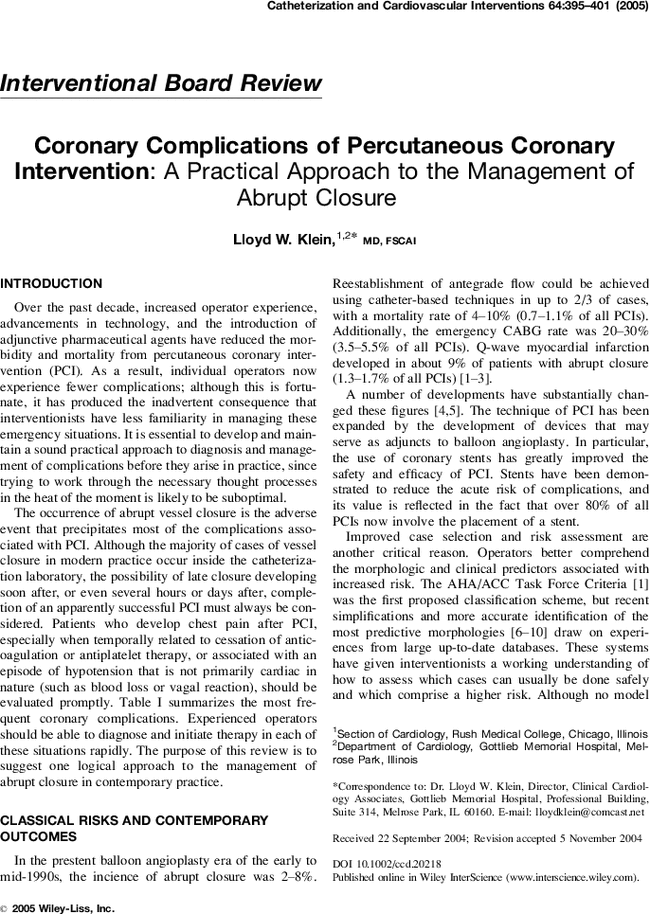Coronary Artery Disease
Coronary complications of percutaneous coronary intervention: A practical approach to the management of abrupt closure
Lloyd W. Klein MD, FSCAI,
Corresponding Author
Lloyd W. Klein MD, FSCAI
Section of Cardiology, Rush Medical College, Chicago, Illinois
Department of Cardiology, Gottlieb Memorial Hospital, Melrose Park, Illinois
Clinical Cardiology Associates, Gottlieb Memorial Hospital, Professional Building, Suite 314, Melrose Park, IL 60160Search for more papers by this authorLloyd W. Klein MD, FSCAI,
Corresponding Author
Lloyd W. Klein MD, FSCAI
Section of Cardiology, Rush Medical College, Chicago, Illinois
Department of Cardiology, Gottlieb Memorial Hospital, Melrose Park, Illinois
Clinical Cardiology Associates, Gottlieb Memorial Hospital, Professional Building, Suite 314, Melrose Park, IL 60160Search for more papers by this author
REFERENCES
- 1 Ryan TJ, Baumann WB, Kennedy JW, et al. Guidelines for percutaneous transluminal coronary angioplasty: a report of the AHA/ACC Task Force. J Am Coll Cardiol 1993; 22: 2033–2055.
- 2
Lincoff AM,
Popma JJ,
Ellis SG,
Topol EJ.
Abrupt vessel closure complicating coronary angioplasty: clinical,angiographic and therapeutic profile.
J Am Coll Cardiol
1992;
20:
926–935.
10.1016/0735-1097(92)90272-O Google Scholar
- 3 de Feyter PJ, van den Brand M, Laarman GH, van Dombud R, Serruys PW, Surypranata H. Acute coronary artery occlusion during and after percutaneous transluminal coronary angioplasty: frequency, prediction, clinical course, management and follow up. Circulation 1991; 83: 927–936.
- 4 Shaw RE, Anderson HV, Brindis RG, Krone RJ, Klein LW, McKay CR, Block PC, Shaw LJ, Weintraub WS, on behalf of the ACC-NCDR Development of a risk adjustment mortality model using the American College of Cardiology National Cardiovascular Data Registry experience: 1998–2000. J Am Coll Cardiol 2002; 39: 1104–1112.
- 5
Chaitman BR,
Rosen AD,
Williams DO, et al.
Myocardial infarction and cardiac mortality in the bypass angioplasty revascularization investigation (BARI) randomized trial.
Circulation
1997;
96:
162–170.
10.1161/01.CIR.96.7.2162 Google Scholar
- 6 Ellis S. Coronary lesions at increased risk. Am Heart J 1995; 130: 643–646.
- 7 Zaacks SM, Allen JE, Calvin JE, Schaer GL, Palvas BW, Parrillo JE, Klein LW. The value of the ACC/AHA stenosis morphology classification for coronary interventions in the late 1990's. Am J Cardiol 1998; 82: 43–49.
- 8 Krone RJ, Laskey WK, Johnson C, Kimmel SE, Klein LW, Weiner BH, Cosentino JJA, Johnson SA, Babb JD, for the Registry Committee of the Society for Cardiac Angiography and Interventions. A simplified lesion classification for predicting success and complications of coronary angioplasty. Am J Cardiol 2000; 85: 1179–1184.
- 9 Krone RJ, Kimmel SE, Laskey WK, Klein LW, Schechtman KB, Cosentino JJA, Babb JD, Weiner BH, for the Registry Committee of the Society for Cardiac Angiography and Interventions. Evaluation of the Society for Coronary Angiography and Interventions' (SCAI) lesion classification system in 14,133 patients with percutaneous coronary interventions (PCI) in the current stent era. Catheter Cardiovasc Interv 2002; 55: 1–7.
- 10 Krone RJ, Shaw RE, Klein LW, Block PC, Anderson HV, Weintraub WS, Brindis RG, McKay CR, on behalf of the ACC-NCDR. Evaluation of the ACC/AHA and the SCAI lesion classification system in the current “stent” era of coronary interventions from the ACC-National Cardiovascular Data Registry. Am J Cardiol 2003; 92: 389–394.
- 11 Leopold JA, Jacobs AK. Treatment of closure and threatened closure. In: SG Ellis, DR Holmes, editors. Strategic approaches in coronary intervention, 2nd ed. Philadelphia: Lippincott Williams and Wilkins; 2000 p 489–501.
- 12 EPIC investigators. Use of a monoclonal antibody directed against the platelet glycoprotein IIb/IIIa receptor in high-risk coronary angioplasty. N Engl J Med 1994; 330: 956–961.
- 13 EPILOG investigators. Platelet glycoprotein IIb/IIIa receptor blockade and low-dose heparin during percutaneous coronary intervention. N Engl J Med 1997; 336: 1689–1697.
- 14 EPISTENT investigators. Evaluation of platelet IIb/IIIa inhibitor for stenting: randomized placebo-controlled and balloon angioplasty controlled trial to assess safety of coronary stenting with use of platelet glycoprotein IIb/IIIa blockade. Lancet 1998; 352: 87–92.
- 15 Klein LW, Kutcher MA, Block P, Krone R, Weintraub WS, Shaw RE, for the ACC-NCDR registry. Emergency CABG after failed PCI in contemporary practice: a report from the ACC-NCDR registry. J Am Coll Cardiol 2002; 39: 41A.
- 16 Losordo DW, Rosenfield K, Pieczek A, et al. How does angioplasty work? serial analysis of human iliac arteries after percutaneous transluminal coronary angioplasty—a quantitative arteriographic analysis. Circulation 1988; 78: 1323–1334.
- 17 Huber MS, Mooney JF, Madison J, Mooney MR. Use of a morphologic classification to predict clinical outcome after dissection from coronary angioplasty. Am J Cardiol 1991; 68: 467–471.
- 18 Kahn JK, Hartzler GO. The spectrum of symptomatic coronary air embolism during balloon angioplasty: causes, consequences, and management. Am Heart J 1990; 119: 1374–1377.
- 19 Klein LW, Kern MJ, Berger P, Sanborn T, Block P, Babb J, Tommaso C, Hodgson JM, Feldman T, on behalf of the Interventional Committee of the Society of Cardiac Angiography and Interventions. Suggested management of the no-reflow phenomenon in the cardiac catheterization laboratory. Catheter Cardiovasc Interv 2003; 60: 194–201.
- 20
Klein LW.
The significance of creatine kinase release after coronary interventions.
Catheter Cardiovasc-Interv
1999;
48:
130–132.
10.1002/(SICI)1522-726X(199910)48:2<130::AID-CCD2>3.0.CO;2-T CAS PubMed Web of Science® Google Scholar
- 21 Kong TQ, Davidson CJ, Meyers SN, et al. Prognostic implications of creatine kinase elevation following elective coronary interventions. JAMA 1997; 227: 461–466.
- 22 Ioannidis JPA, Karvouni E, Katritsis DG. Mortality risk conferred by small elevations of creatine kinase-MB isoenzyme after percutaneous coronary intervention. J Am Coll Cardiol 2003; 42: 1406–1411.
- 23 Blankenship JC, Islam MA, Wood GC, Iliadis EA. Angiographic adverse events during percutaneous coronary intervention fail to predict creatine kinase-MB elevation. Catheter Cardiovasc Interv 2004; 63: 31–41.
- 24
Kini A,
Kini S,
Marmur JD, et al.
Incidence and mechanism of creatine kinase-MB enzyme elevation after coronary intervention with different devices.
Catheter Cardiovasc Interv
1999;
48:
123–129.
10.1002/(SICI)1522-726X(199910)48:2<123::AID-CCD1>3.0.CO;2-O CAS PubMed Web of Science® Google Scholar




